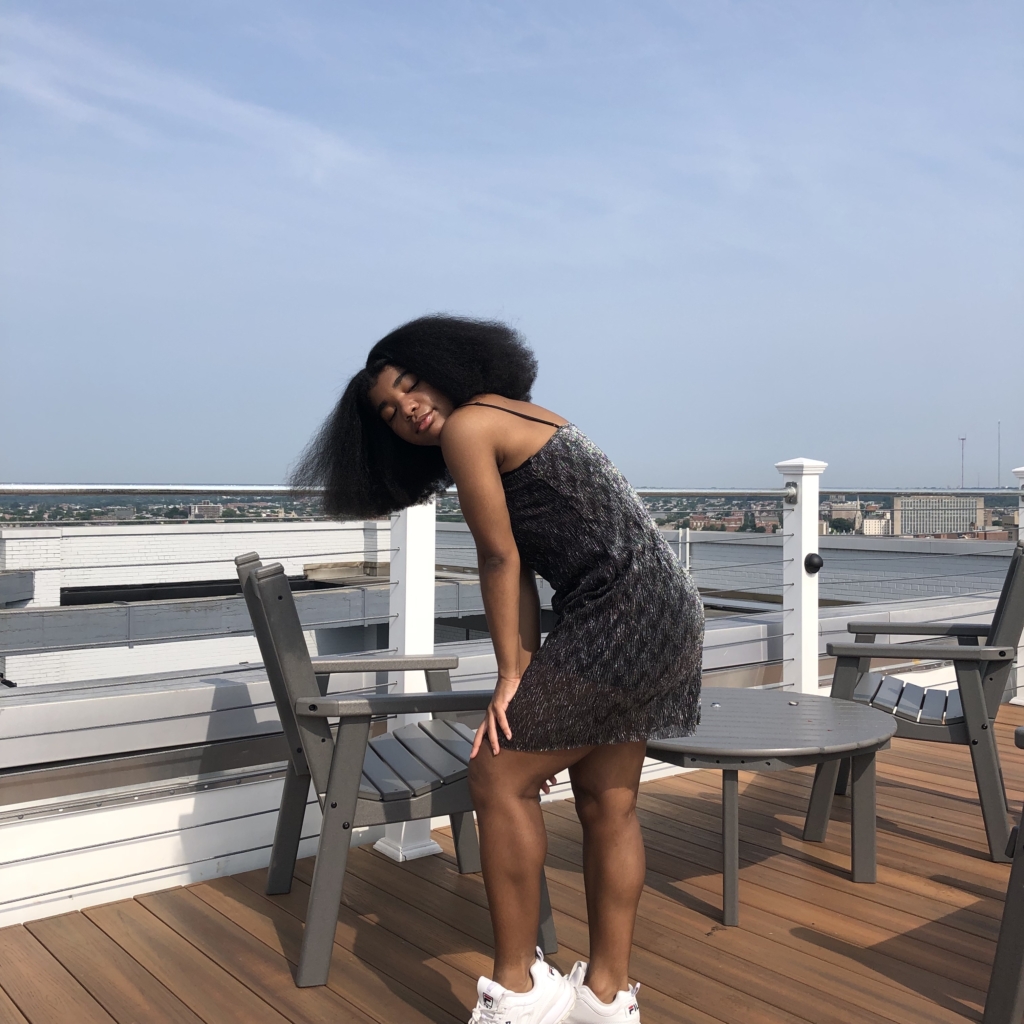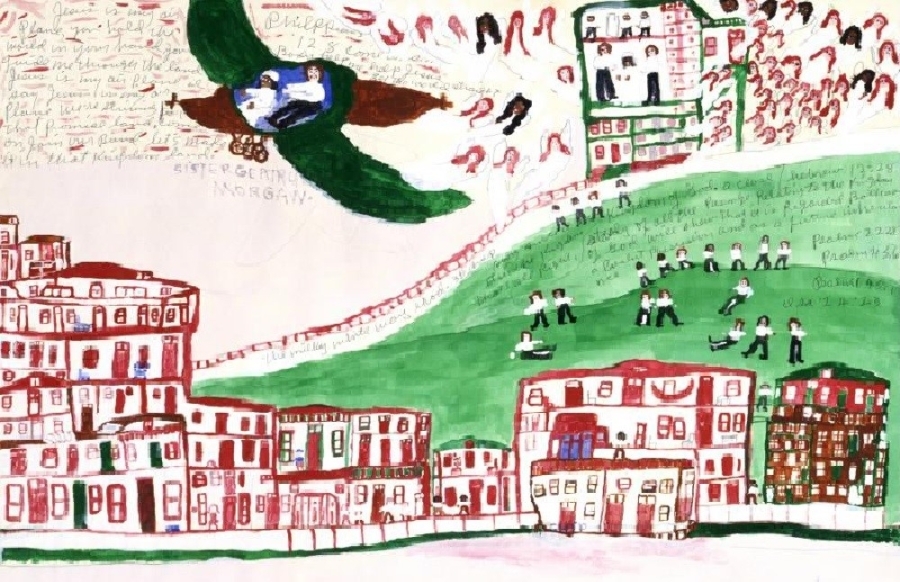AN INTERVIEW CONDUCTED BY MORGAN LEVINE
Bryn Evans received our Spring 2020 Poetry Prize for her poem “Thotiana’s interlude, or Barbara Mason reconsiders settling down.” Bryn and I called each other from our respective hometowns of Decatur, Georgia and Houston, Texas for this interview, which has been lightly edited for clarity. I’ve been a fan of Bryn’s work since my freshman year at Columbia, when we were in Anaïs Duplan’s poetry workshop together, so I was beyond excited to talk to her about Afrofuturism, time travel, art history, and (of course) poetry.
ML: So we’re here to talk about you and your poem “Thotiana’s interlude, or Barbara Mason reconsiders settling down,’ which won our Spring 2020 Poetry Prize. I love that poem, and I love that title — can you tell me more about what these two figures, Thotiana and Barbara Mason, are doing in this poem?
BE: It’s an intergenerational dialogue. I’m taking this Barbara Mason figure who is representing R&B, older Black feminisms, and she’s very subversive in that she’s not writing typical love songs: she’s willing to be a side piece, a side chick, what have you. And also this Thotiana trope — I guess Blueface would understand Thotiana as a Black woman who is good at twerking and is sexually promiscuous. So understanding promiscuity and how it can be empowering and liberating, because at the end of the day, marriage is a very contractual, liberal, dangerous idea. Essentially, I have them in conversation to think about Black feminine interiority and how our sexualized bodies are in many ways tools that we can employ. I’m interested in the power of willing self-commodification in the wake of the rampant sexual abuse that’s perpetuated in our society, where the Black femme body is read as a site impossible to violate because it is never regarded as our own. I don’t think self-commodification is an inherently bad thing, I think it’s resourceful, intellectual, and necessary at times. I think it acknowledges the agency that Black femmes are often denied, which leads me to ask how transgression is working and being re-worked by the speakers here. I was very concerned about voice. There are two remixes to Thotiana by Blueface, one with Cardi and one with Nicki. So you have the voice, but looking at those lyrics — I love Cardi and Nicki, but it’s not what I wanted. So this is me dropping my verse, you could say. And also listening to Barbara Mason and this cognitive dissonance, this reconsideration of whether the role she’s occupying in this relationship is actually to her benefit. So considering that.
ML: Yes. That’s so cool. And I think you feel that ambiguity, that dissonance as the voice wraps itself around the situation — were there any specific inspirations behind the piece?
BE: I was coming out of wanting to offer a space for Black women not feeling heard, and my own experience with slurs that are meant to degrade women and sexualize our bodies in ways that are not uplifting. I remember I was in 9th grade, we had this thing called the waiting bus for kids whose parents took a while to pick them up after school, and this guy came over and called me a thot. I didn’t really know what it meant; I turned to the girl next to me and she explained it, and I was just like… I do not know this man. So thinking about how courting happens in public and private spaces. In the poem, I am interested in this multi-temporal, multi-spatial environment/universe, where all these things can happen at once and still be true, even though they might contradict. Even though it’s Barbara Mason and Thotiana, it’s also me there, 9th grade, being called this and wondering what I’m supposed to be doing with that information.
ML: Yes, totally, all cyclical and happening at once, which reminds me of Afrofuturism, which we will talk about later. I’ve been lucky enough to read some of your other poems and a lot of them also play with these silent elements of language — breath, white space, punctuation. I’m curious about the parentheticals in this poem and what absence is doing here, especially in the context of what we just talked about, time and repetition. Can you maybe speak some on that and where this broader interest in punctuation and symbols stems from?
BE: I first started thinking more about space and punctuation and signifiers when I was grappling with the limits of the page. Especially when you’re in workshop, you don’t know how things are going to be read. It’s my way to assist the reader in breathing, and also seeing differently. I understand the limits of my own readership, and I want to assist other people who are encountering my work as much as possible, while also allowing a certain freedom. There’s often at least four different ways to read my poems because I’m interested in that multiplicity of meaning. Space provides a sort of tension, both interiority and considering what’s not being said — how words can be so full but also opaque in that way. Thinking about opacity, literally whiteness, thinking about race and visibility. I’ve been reading Zora Neale Hurston, How It Feels To Be Colored Me, again and she says “I feel most colored when I am thrown against a sharp white background.” So thinking also about the formal elements of the page (text, space, break), and how my poetry embodies and disembodies that thought. And also shoutout An, An was really encouraging me to be creative about my form. So a lot of different things, but that’s probably one of my favorite parts of writing poetry. The puzzles underneath.
ML: And I feel that in your work so much — your poems often feel tense to me, but they never feel strict. I never feel confined in the way to read them or in meaning. That’s something that I really love about reading your work. You also just won the Beinecke Scholarship, so massive congratulations for that. Can you tell us a little bit about what you plan to explore with that scholarship?
BE: Thank you! My answer to this question changes every day. I’m interested in myself: a Southern Black woman living in the South, and the violences that I experience on a daily basis. I think domestic violence is often this very extreme and pathologized term, which I am dissociating from because it also manifests in very mundane acts, and that needs to be acknowledged. So I’m thinking about domestic violence and spatio-temporal violence in the largest way possible, and intimacy and how those lines are often blurred, and what do we make from that. I’ve gotten really interested in housing discrimination and inequality down here, and also racial capitalism. Me coming from an art history background, it doesn’t make a lot of sense to many people in my home field, whatever that is, but I’m interested in visuality and interiority in architecture. I’ve been thinking about pursuing a PhD in African-American studies and Art History, or an interdisciplinary studies field just because my interests are so far-reaching. But after growing up down here (Decatur, Georgia), my first critical lens observing homes did happen in my art historical research. Thinking about visionary artists like Sister Gertrude Morgan, a late evangelist street preacher in New Orleans whose Jesus is my air Plane beautifully captures the vernacular landscapes and the liberating possibility of Black religiosity and spirituality. I think most people do not think of Christianity in that way, and rightfully so, it’s a very violent religion. But my whole Beinecke thing came out of thinking about this woman who never attended art school, who is deemed an outsider artist; thinking about outsider art as one who is born out of that liminal space, inside of the outside.
ML: Even the terms outsider art, visionary art, naive art. All so loaded. How do those ideas and the interdisciplinary nature of your work play into what Afrofuturism is to you, and to this poem specifically?
BE: Dr. David Wall Rice explained enfranchisement as our voices being accounted for and heard and being of consequence, and Afrofuturism for me is imagining and working in such a way that gives rise to sustainable Black living in the future where our lives are of consequence. Black Lives Matter is such a loaded and often commodified term these days, but that “matter” is being of consequence. I’m not a quantum physicist but I am interested in black holes and gravity. Weight. That’s what I’m interested in. I guess that does ring true to the Afrofuturist-science-fiction-nerdy tradition, but I think at my root I’m interested in a future where the most marginalized, and that’s another weighted term, where the most marginalized are heard and of consequence and where we matter.
ML: Yes, where Barbara Mason and Thotiana can meet in one poem and examine their perspectives.
BE: And twerk and have fun while doing it.
ML: Absolutely. To wrap things up, first: looking outwards, what would be some genres or other mediums of art that you would be interested in collaborating with or learning alongside your poetry?
BE: I dance, so thinking about the choreopoem and how that might potentially manifest in my work. My memory is not the best, so choreography always turns to improv, but I think that’s the beautiful thing about the choreopoem, that like poetry, dance is so embodied. Dr. Jasmine Johnson’s work is so amazing: she has this essay called “Flesh Dance” that I think really speaks to this poem in interesting ways, I recommend everyone read it. Thinking about Hurston, oral history and folklore. I don’t like structure and boundaries and strict genres, and I think oral history and the choreopoem allow me to do that. Also photography. Photography offers a certain type of violence. When you think about the language of photography: you shoot, you capture, there’s a subject and so many other things. I think photography is very meta in that you have to think about what’s outside the frame, what’s inside the frame, the gaze and how that works. So also photography.
ML: I know that Fred Moten, who we both love, has in all that beauty a bit about photography being an auditory experience and capturing background noise, and then I just finished Mary Hickman’s Rayfish and she talks about how photography argues that there is only one reality, only one narrative, but it only argues it, it never succeeds. And that feels really true to me especially when combined with these other boundary-breaking aspects of your work; it seems so exciting to bring photos into that. So, lastly, what is some work that you’re really loving right now and would recommend to us, to our readers. Put us in some directions.
BE: Celebrate, honor, be a patron of, support Black, queer, trans, non-binary individuals who are still thriving and surviving during this violent time. Support your Black teachers. My mom is a teacher and she just came off of a very rocky semester due to the pandemic. Being at home and observing her work has really created this newfound appreciation for teachers and the work that they do in raising children. Also, I plug Black Quantum Futurism and Rasheedah Phillips and the work that they are doing. SisterSong and Mobile Homecoming, Alexis Pauline Gumbs, some beautiful organizations I suggest supporting.
ML: Well, thank you so much for talking with us, it has been an absolute pleasure.
BE: Of course!

Read Bryn’s poem and more in our Spring Issue.

